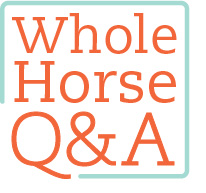Q I worry about enteroliths. The stable where my horse is boarded feeds alfalfa or alfalfa-mix hay, and I’ve heard alfalfa can be a factor in stone formation. What are the warning signs, and how can I keep an enterolith from forming in my gelding?

JENNIFER VAUGHN, California
A Enteroliths are formed from plant and mineral concretions within a horse’s digestive tract. Typically located in the large or small colon, they’re similar to gallstones in people and can lead to obstruction, resulting in signs of colic.
Equine enterolithiasis is strongly associated with specific regions of the country; your state, California, has the highest incidence by far (Texas and Florida are distant seconds). According to a 1999 study, approximately 27.5 percent of horses undergoing abdominal surgery for colic at U.C. Davis were diagnosed with enterolithiasis. Other risk factors for enterolith formation include a diet of primarily alfalfa hay, the breed of the animal (Arabians, Morgans, Saddlebreds, Miniature Horses, and donkeys are more susceptible), and a higher-than-average mineral content and pH level of the large colon’s contents.
X-raying the abdomen is the main way enteroliths are positively diagnosed (see box at right).

Preventive measures include increasing pasture access so that a horse is turned out more than 50 percent of the time, plus decreasing or eliminating alfalfa hay consumption if the horse lives in a high-risk area of the country. Some veterinarians have also advocated acidifying the contents of the colon (by adding one cup of apple cider vinegar to feed twice a day—for a 1,000-pound horse). Removing access to dirt and gravel are additional safeguards to help prevent stones from starting.
Horses with enteroliths in their large colon may exhibit intermittent signs of mild colic, and may even pass a few smaller enteroliths in their manure. (Colic signs can range from pawing or looking at the flank to getting up and down frequently or rolling.) If acute obstruction of the large or small colon occurs, colic signs become more severe and you may notice abdominal distention.
Surgical removal of enteroliths generally has an excellent success rate (greater than 90 percent). The process involves manual movement of the enterolith(s) to an accessible part of the bowel, then surgical removal by cutting into the intestine. If the pressure from an enterolith has caused local necrosis (tissue death), then bacterial contamination/absorption or bowel rupture may worsen the prognosis. For this reason, early surgical intervention can increase the chances of a successful outcome.
STACY A. SEMEVOLOS, DVM, DACVS
Professor of Large Animal Surgery
Oregon State University






